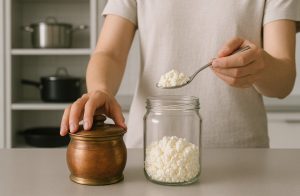Have you ever wondered why some traditional practices, despite their cultural value, are no longer recommended in modern households? One such practice that raises concern is storing curd and other sour substances in brass and copper vessels.
This might appear harmless or even beneficial to some, especially in regions where such metals were widely used for centuries. However, there is increasing awareness and scientific consensus around the dangers of storing acidic foods in reactive metal containers.
The question then becomes not only about why it is harmful, but also how it affects food quality, health, and safety. This blog aims to answer that question in detail, drawing from chemistry, health research, and traditional knowledge that has evolved through scientific understanding.
What Makes Brass and Copper Reactive Towards Acidic Foods?

Brass and copper are both metals with specific characteristics that make them highly reactive with acidic and fermented substances. While copper is a pure metal, brass is an alloy primarily made of copper and zinc, both of which can interact with acids under certain conditions.
Acidic foods, such as curd, lemon juice, tamarind, vinegar, and pickles, contain organic acids like lactic acid, citric acid, acetic acid, and tartaric acid. When these acids come in contact with brass or copper, a chemical reaction occurs, leading to the formation of metallic salts and hydrogen gas.
The general reaction is as follows:
Acid (from food) + Copper/Zinc (from vessel) → Metallic Salt + Hydrogen Gas
These metallic salts such as copper lactate or zinc acetate are soluble and toxic. While they may not affect the smell or immediate taste of the food, they contaminate it with harmful compounds that can cause short-term illness or long-term toxicity if consumed regularly.
How Does This Reaction Affect the Safety and Quality of Food?
The interaction between metal and acid is not merely a chemical curiosity, it has serious implications for human health. Once food becomes contaminated with metal salts, it is no longer safe to eat.
These compounds can irritate the stomach lining, disrupt normal digestion, and even lead to neurological or organ-related damage when consumed over long periods.
In many cases, the contamination may go unnoticed. The food might retain its colour, smell, and even taste, but would still be chemically altered in a way that is not suitable for consumption. This silent contamination makes the practice of storing sour foods in reactive metals particularly dangerous, as it gives a false impression of safety.
What Are the Immediate and Long-Term Health Risks?

The ingestion of copper and zinc salts can cause a wide range of gastrointestinal and systemic issues. In the short term, people may experience:
- Nausea
- Vomiting
- Abdominal cramps
- Diarrhoea
- Metallic taste in the mouth
These symptoms are often dismissed as minor food poisoning, making it difficult to trace the true cause.
Over time, the continuous ingestion of these metals can lead to:
- Accumulation of heavy metals in the liver and kidneys
- Interference with nutrient absorption
- Disruption in neurological functions
- Damage to intestinal lining and gut microbiome
- Possible increase in the risk of metal toxicity
Vulnerable groups such as children, pregnant women, and the elderly are at higher risk due to their lower metabolic resistance and greater sensitivity to toxins.
What Happens When Specific Sour Substances Come in Contact with Brass and Copper?
To understand the reaction better, let us examine how various sour substances interact with these metals:
| Substance | Type of Acid Present | Metal Reaction | Harmful Outcome |
| Curd | Lactic Acid | Reacts with copper/zinc to form salts | Formation of copper lactate – toxic |
| Lemon Juice | Citric Acid | Accelerates corrosion | Taste alteration, heavy metal leaching |
| Tamarind | Tartaric Acid | Strong acidic reaction | Corrosion, bitterness, and salt formation |
| Vinegar | Acetic Acid | Dissolves surface of metal | Copper acetate – hazardous to health |
| Pickles | Mixed acids + salt | Promotes erosion of metal | Contamination, altered pH of food |
These reactions often produce hydrogen gas, though in small, non-explosive amounts. Still, it contributes to spoiling the taste and fermentation process, especially if the food is sealed or stored for extended periods.
Why Did Our Ancestors Use Brass and Copper, Then?
It is important to understand that while traditional practices often carry wisdom, they were also shaped by the materials and knowledge available at the time. Historically, copper and brass were widely used, but their usage was different:
- Vessels were tinned regularly with a layer of lead or tin, forming a non-reactive lining that protected food from direct metal contact.
- They were mostly used for cooking or serving, not long-term storage of sour or acidic foods.
- Fermented foods were often stored in earthen pots, ceramic jars, or banana leaves, which were more appropriate for preserving food safely.
In modern times, however, regular tinning is no longer common, and many households use untreated metal vessels due to aesthetic appeal or lack of awareness, which creates a health risk that did not exist in the same way in the past.
Are There Safer Alternatives for Storing Sour Foods?

Yes, and they are not only safer but also readily available. Non-reactive materials are the ideal choice for storing curd and other acidic foods. The most commonly recommended options include:
- Stainless steel: It is chemically stable, rust-resistant, and easy to clean.
- Glass: Offers excellent chemical resistance, transparency, and hygiene.
- Ceramic jars (glazed): Ideal for pickles and fermented foods; inert and traditional.
- Food-grade plastic: Acceptable for short-term storage, especially for transport or refrigeration.
These materials do not react with acids and therefore do not compromise food safety or nutritional value. They are also easier to clean and maintain in the long term.
Can Food Stored in Copper or Brass Still Appear Normal?
One of the most dangerous aspects of this practice is that the contaminated food may not show visible signs of spoilage. Unlike bacterial contamination, which often results in a foul smell or change in texture, metal contamination is chemically silent.
The food might look, taste, and smell perfectly normal but still be loaded with toxic metallic compounds. This deceptive appearance is what makes the habit particularly harmful, as people unknowingly consume foods that could affect their health gradually over time.
How Can Modern Kitchens Avoid These Hazards?

Kitchen safety involves more than hygiene and temperature control, it requires an understanding of how materials interact with food substances. Avoiding brass and copper for sour food storage is a simple but powerful change. Modern kitchens can adapt the following safe practices:
- Use only non-reactive containers for acidic or fermented food storage.
- Do not reuse brass or copper utensils for curd, pickles, or lemon-based dishes.
- If using traditional vessels for aesthetic or cultural purposes, ensure they are lined with tin or used only for dry items or serving.
- Educate household members and domestic staff about safe storage practices.
This change does not require a complete overhaul of your kitchen, just a shift in awareness and application of scientific understanding.
Frequently Asked Questions
Can I store curd in a copper pot if it’s brand new?
Even brand-new copper vessels can react with acids present in curd. Unless the pot is properly lined and the coating is intact, storing curd in copper is not safe.
What are copper and zinc salts, and why are they dangerous?
These salts are formed when acidic substances react with copper or brass. When consumed, they can lead to nausea, vomiting, and long-term health effects including metal toxicity.
Is hydrogen gas from this reaction dangerous?
While not explosive in this context, hydrogen gas formation indicates a chemical reaction is occurring. It may spoil fermentation and produce off-flavours in sealed foods.
Are tinned brass vessels safer?
Yes, traditionally tinned vessels (called “kalai” in South Asia) form a barrier that prevents direct metal-food interaction. However, the coating must be maintained regularly to remain effective.
How can I identify if food is contaminated by metal?
Unfortunately, metal contamination is not always visible or detectable through taste. Prevention through proper storage materials is the safest approach.
Why do some people still store pickles in brass jars?
Due to lack of awareness or adherence to outdated practices. Education and scientific understanding now discourage this practice due to proven health risks.
Are modern copper bottles safe for water?
Yes, storing water in copper bottles can offer some antimicrobial benefits. However, they are not suitable for acidic or flavoured water.
READ MORE:






